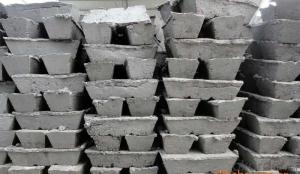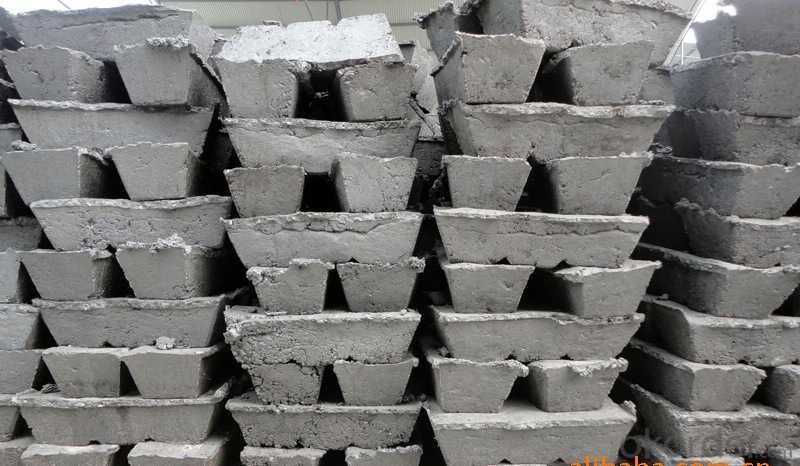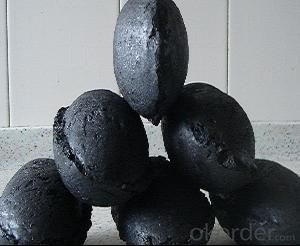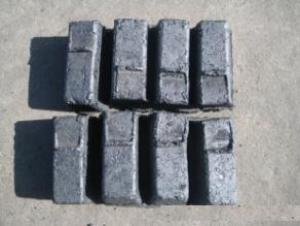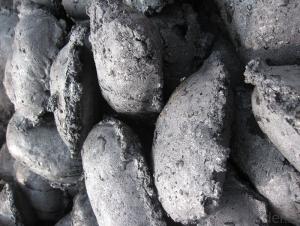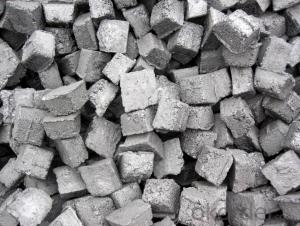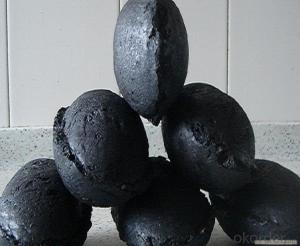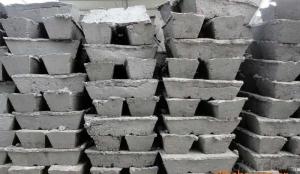Carbon Electrode Paste -Ash7 with Good Quality Low Ash
- Loading Port:
- Lianyungang
- Payment Terms:
- TT OR LC
- Min Order Qty:
- 20 m.t.
- Supply Capability:
- 2000 m.t./month
OKorder Service Pledge
OKorder Financial Service
You Might Also Like
Spcifications
1:carbon eletrode paste
2:for ferroalloy,calcium carbide manufacture
3:HS 3801300000,YB/T5212-1996,ISO9001:2008
Product Description
Carbon Electrode Paste is a self-baking electrode used in submerged arc furnaces for delivering power to the charge mix. Electrode Paste is added to the top of the electrode column in either cylindrical or briquette form. As the paste moves down the electrode column the temperature increase causes the paste to melt and subsequently bake forming a block of electrically conductive carbon. Electrode Paste is essentially a mix of Electrically Calcined Anthracite (ECA) or Calcined Petroleum Coke (CPC) with Coal Tar Pitch.
Graphite/Carbon Electrode Paste Specification:
PARAMETER UNIT GUARANTEE VALUE
Ash.( % ) 4.0 max5.0 max 6.0 max 7.0 max 9.0 max11.0 max
V.M (%) 12.0-15.512.0-15.5 12.0-15.5 9.5-13.5 11.5-15.511.5-15.5
Compress Strength. 18.0 min17 min 15.7 min 19.6 min 19.6 min19.6 min
Specific Resistance 65 max68 max 75 max 80 max 90 max90 max
Bulk Density 1.38 min1.38 min1.38 min 1.38 min 1.38 min1.38 min
Picture:
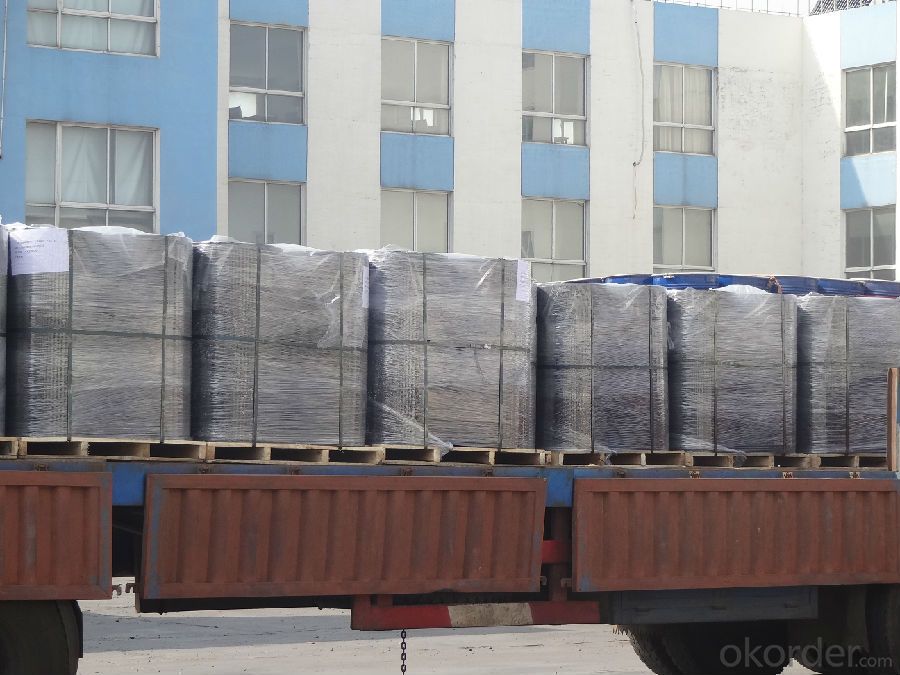
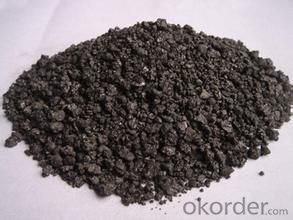
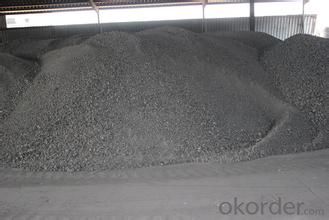
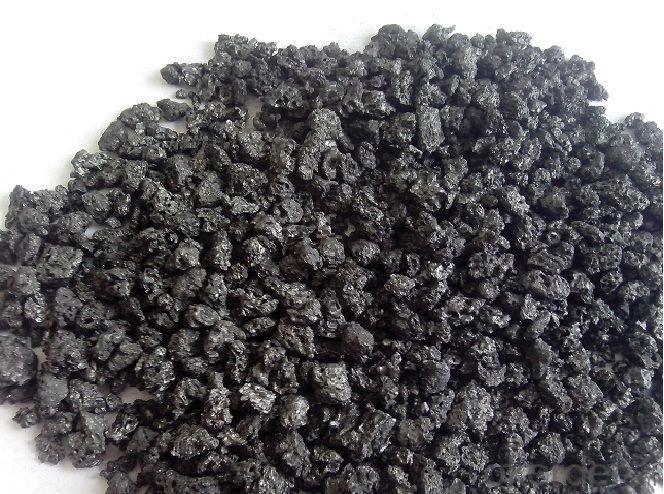
Company information:
China National Building Materials Group is a stated -owned enterprise in charge of administrative affairs in China buiding materials industry.Established in 1984 CNBM is a large group corporation of building materials with total assets of 25 billion and a total stuff of 30000 CNBM now owns 200 subordinating firms of solely owned and joint-venture companies.
- Q: RT~ I remember our teacher said, but I forgot all of a sudden......Ask for advice!
- Well, secondary carbon and oxygen double bonds do not add much. What is involved in high school?:1, in the nickel catalyzed conditions, with H2 addition (also a reduction, but note that in the carboxyl group -COOH carbon oxygen double bond can not be added by the general method plus H)2, aldehyde addition (aldol condensation). The college entrance examination had many times, is simply an aldehyde -CHO under certain conditions and containing active H group reaction R-H (commonly known as alpha H that -H doesn't have to be in the next -CHO H, like -COOH, phenyl can also, but to see more in the next -CHO generation of C- (OH) -R). The H is added to the O, and the alkyl R- is added to the C.For example: CH3-CHO+HCHO==CH3-C (OH) -CHO (called 2- 3-hydroxypropanal)There are some universities, the mechanism involved is more complex, you want to HI me
- Q: What is the role of carbon in the formation of fossil fuels?
- Carbon plays a crucial role in the formation of fossil fuels. Fossil fuels, including coal, oil, and natural gas, are formed from the remains of ancient plants and organisms that lived millions of years ago. These ancient organisms contained a significant amount of carbon, which is the primary component of fossil fuels. The process of fossil fuel formation begins with the decomposition of organic matter. When plants and organisms die, their remains accumulate in an environment with limited oxygen, such as swamps, lakes, and ocean floors. Over time, these organic materials are buried under layers of sediment, subjecting them to immense pressure and heat. Under these extreme conditions, the organic matter undergoes a process called diagenesis, which involves the breakdown of complex organic molecules into simpler compounds. This process releases gases like methane and carbon dioxide. However, the carbon-rich compounds that resist decomposition become the building blocks of fossil fuels. Over millions of years, the pressure and heat continue to transform these organic remains. The carbon-rich compounds undergo a process called catagenesis, where they get progressively altered, forming hydrocarbon chains. This transformation leads to the formation of coal, oil, and natural gas, which are all composed primarily of carbon, hydrogen, and a few other elements. The carbon present in fossil fuels is responsible for their high energy content. When burned, fossil fuels release carbon dioxide and other greenhouse gases into the atmosphere, contributing to climate change. However, the role of carbon in the formation of fossil fuels is crucial as it provides a concentrated source of energy that has been vital for human civilization and industrial development.
- Q: How is carbon used in the production of filters?
- Carbon is commonly used in the production of filters due to its unique properties. One of the main uses of carbon in filters is its ability to adsorb, or attract and hold onto, impurities and contaminants. This is because carbon has a large surface area with many tiny pores, allowing it to effectively trap and remove particles, chemicals, and odors from air, water, and other substances. In air filters, carbon is often combined with other materials, such as activated charcoal, to create activated carbon filters. These filters are used to remove pollutants, allergens, and odors from the air. The activated carbon adsorbs the contaminants, trapping them within its porous structure and improving the overall air quality. In water filters, carbon can be used in different forms, such as granular activated carbon (GAC) or carbon block filters. GAC filters are commonly used in household water filtration systems and are effective in removing chlorine, volatile organic compounds (VOCs), pesticides, and other chemicals. Carbon block filters, on the other hand, are made by compressing activated carbon into a solid block, providing a higher surface area and better filtration efficiency. In addition to air and water filters, carbon is also used in various other types of filters, such as those used in industrial processes, gas masks, and respirators. The versatility of carbon in filtering applications is due to its ability to adsorb a wide range of contaminants and its high adsorption capacity. Its use in filters helps improve the quality and safety of the substances being filtered, making it an essential material in many filtration processes.
- Q: What are the consequences of increased carbon emissions on economic stability?
- Increased carbon emissions have significant consequences on economic stability. One of the most notable impacts is the exacerbation of climate change, leading to more frequent and severe natural disasters such as hurricanes, floods, and wildfires. These events result in immense economic damage, including the destruction of infrastructure, loss of property, and disruption of supply chains. Furthermore, the effects of climate change, driven by increased carbon emissions, also have long-term economic implications. Rising sea levels threaten coastal cities and industries, leading to the potential displacement of populations and loss of valuable assets. Extreme heatwaves and droughts can damage agricultural productivity, affecting food security and increasing prices. These climate-related disruptions can destabilize economies, particularly in vulnerable regions heavily reliant on agriculture or tourism. Additionally, efforts to mitigate and adapt to climate change, such as transitioning to cleaner energy sources and implementing climate policies, require significant financial investments. This can strain government budgets and divert resources away from other socio-economic priorities, potentially leading to reduced funding for education, healthcare, and infrastructure development. Moreover, the economic consequences of increased carbon emissions extend beyond immediate climate-related impacts. The reliance on fossil fuels as the primary source of energy contributes to volatile oil prices, which can disrupt global markets and impact economic stability. As the world moves towards a low-carbon economy, industries heavily dependent on fossil fuels may face significant challenges, leading to job losses and economic dislocation. In summary, increased carbon emissions have far-reaching consequences on economic stability. The resulting climate change leads to more frequent and severe natural disasters, causing substantial economic damage. Furthermore, the need to respond to climate change through mitigation and adaptation efforts can strain government budgets and divert resources away from other essential sectors. Lastly, the reliance on fossil fuels contributes to volatile oil prices and poses long-term risks to industries tied to these resources. Addressing carbon emissions is crucial for safeguarding economic stability and promoting sustainable growth.
- Q: How does carbon affect the formation of tsunamis?
- Carbon does not directly affect the formation of tsunamis. Tsunamis are typically caused by underwater earthquakes, volcanic eruptions, or landslides, which are not influenced by carbon. However, carbon emissions and climate change can indirectly impact the frequency and intensity of natural disasters, including some potential triggers for tsunamis, such as volcanic activity or landslides near coastlines.
- Q: How do carbon emissions contribute to extreme weather events?
- Carbon emissions contribute to extreme weather events through the process of climate change. When carbon dioxide and other greenhouse gases are released into the atmosphere, they trap heat from the sun and cause the Earth's average temperature to rise. This phenomenon, known as global warming, is largely driven by human activities such as burning fossil fuels for energy, deforestation, and industrial processes. As the planet warms, it disrupts the delicate balance of weather patterns, leading to an increase in extreme weather events. Here are a few ways carbon emissions contribute to these events: 1. Heatwaves: Increased carbon emissions lead to higher temperatures, which in turn increase the frequency and intensity of heatwaves. This can result in prolonged periods of extreme heat, posing risks to human health, agriculture, and ecosystems. 2. Hurricanes and tropical storms: Warmer ocean temperatures caused by carbon emissions provide more energy to fuel hurricanes and tropical storms. This leads to more intense storms with higher wind speeds and heavier rainfall, resulting in increased destruction and flooding. 3. Droughts: Climate change caused by carbon emissions can alter precipitation patterns, resulting in decreased rainfall and increased droughts in certain regions. These prolonged periods of water scarcity can have severe impacts on agriculture, water supplies, and ecosystems. 4. Heavy rainfall and flooding: Global warming intensifies the water cycle, causing more evaporation and moisture in the atmosphere. This leads to heavier rainfall events when precipitation does occur, increasing the risk of flooding and flash floods. 5. Wildfires: Rising temperatures and drier conditions due to climate change create favorable conditions for wildfires. Increased carbon emissions contribute to the length and severity of fire seasons, causing more extensive and destructive wildfires. It is important to note that while carbon emissions contribute to extreme weather events, they are not the sole cause. Other natural climate variability factors, such as El Niño and La Niña, can also influence extreme weather. However, by reducing carbon emissions and transitioning to cleaner energy sources, we can mitigate the impacts of climate change and help prevent further exacerbation of extreme weather events.
- Q: How does carbon affect the formation of desertification?
- The formation of desertification is not directly affected by carbon. Rather, desertification is primarily caused by a combination of natural factors, such as climate change, prolonged drought, and human activities like deforestation and overgrazing. However, carbon does play an indirect role in exacerbating desertification through climate change. Carbon dioxide (CO2), a greenhouse gas, is released into the atmosphere through human activities, particularly the burning of fossil fuels. The increased concentration of CO2 in the atmosphere leads to global warming, which alters climate patterns and increases the frequency and intensity of droughts. Prolonged droughts deplete soil moisture, making the land more susceptible to erosion and degradation, thus contributing to the desertification process. Furthermore, carbon indirectly affects desertification through deforestation. Trees and other vegetation play a vital role in maintaining healthy soil by preventing erosion, retaining moisture, and providing shade. When forests are cleared, the carbon stored in trees is released into the atmosphere, contributing to higher CO2 levels. Additionally, the loss of vegetation cover exposes the soil to erosion by wind and water, which accelerates desertification. It is important to acknowledge that while carbon indirectly impacts desertification through climate change and deforestation, desertification itself is a complex process influenced by various factors. Addressing desertification requires a comprehensive approach involving sustainable land management practices, reforestation efforts, water management, and strategies to mitigate climate change.
- Q: What is coal?
- Coal is a black or brownish-black sedimentary rock that is primarily composed of carbon, along with various other elements such as hydrogen, sulfur, oxygen, and nitrogen. It is formed from the remains of plants that lived and died millions of years ago, accumulating in swampy environments. Over time, the layers of plant material were subjected to high pressure and heat, resulting in the formation of coal. Coal is one of the most abundant fossil fuels on Earth and has been used as a source of energy for centuries. It is typically extracted from underground or surface mines and can be found in different forms, including anthracite, bituminous, sub-bituminous, and lignite, with varying carbon content and heating value. Due to its high carbon content, coal is primarily used for electricity generation and as a fuel for industrial processes. When burned, it releases energy in the form of heat, which is converted into electricity through steam turbines. However, burning coal also releases greenhouse gases and other pollutants, contributing to air pollution and climate change. In addition to its use as a fuel, coal is also used in the production of steel and cement, as well as in various industrial processes. It is a versatile resource that has played a significant role in the development of modern societies, but its environmental impact and finite nature have led to increased efforts to shift towards cleaner and more sustainable energy sources.
- Q: Rod box material, there is a kind of material called carbon fiber, who knows this material is good?
- Very good, carbon fiber is made of organic fiber after a series of heat treatment into, inorganic fiber with high performance carbon content is higher than 90%, is a new material with excellent mechanical properties, the intrinsic properties of natural carbon material with, and both the textile fiber soft processing, is a new generation of fiber. Carbon fiber is a new dual-use material for military and civilian use. It is the key material of technology intensive and politically sensitive. It is the only material that does not drop in the high temperature inert environment above 2000 degrees celsius. Carbon fiber steel accounted for less than 1/4, the tensile strength of composite is generally above 3500Mpa, is 7-9 times that of steel, carbon fiber has superior corrosion resistance, it can also be safe and sound in the dissolution of gold and platinum "aqua".
- Q: What is carbon monoxide poisoning?
- Carbon monoxide poisoning is a potentially life-threatening condition that occurs when a person inhales excessive amounts of carbon monoxide gas. This gas is colorless, odorless, and tasteless, making it difficult to detect without proper monitoring equipment. When inhaled, carbon monoxide displaces oxygen in the bloodstream, leading to oxygen deprivation to vital organs and tissues. Symptoms can range from mild headache and nausea to dizziness, confusion, and even death. It is crucial to have working carbon monoxide detectors in homes and to seek immediate medical attention if poisoning is suspected.
Send your message to us
Carbon Electrode Paste -Ash7 with Good Quality Low Ash
- Loading Port:
- Lianyungang
- Payment Terms:
- TT OR LC
- Min Order Qty:
- 20 m.t.
- Supply Capability:
- 2000 m.t./month
OKorder Service Pledge
OKorder Financial Service
Similar products
Hot products
Hot Searches
